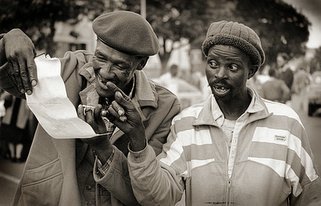
Two comic talents give an impromptu show on a street in Grahamstown, South Africa.
Usually people smile when they see this image. At first it's the expressions that catch the eye, then the hands and finally the tiny details like the dummy in the one guy's hand. I think my composition, the moment I captured, adds to the humour with the raised finger appearing to be under the nose of the other chap and direction of his gaze, all adding to the dynamism of the image.
In an earlier blog I talked about what makes us respond to an image. As I listed there are several factors but the second last point I made in the list is the most important one. We respond to an image because of personal associations and experiences.
The best term I've seen to describe this deep connection that one can have with an image is that it resonates. You can go to a gallery and admire the esthetics, the lighting, the composition, the subject matter and all the rest but if the image does not touch you on a deeper level, if it does not resonate with you, then you are not going to fall under its spell.
It's a strange business. After all these years I've got an idea of the types of image that resonate with me. But a curator could present me with hundreds of pictures that fit the description I could give and yet only a few of those images would actually hit that spot and connect on a deeper level with my inner world.
Sometimes an image that resonates is not technically perfect, other people will walk past it and see nothing special and yet it will stop me dead in my tracks. The whole subject is fascinating and I'll investigate it further because, quite frankly, at the moment this phenomenon is largely a mystery to me.
I'm always interested in hearing your thoughts.
Cheers,
Paul
Comments
Tim